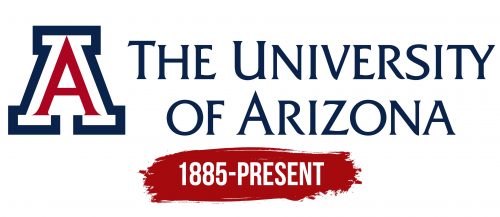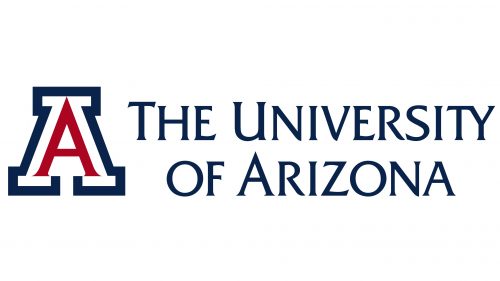 University of Arizona Logo PNG
University of Arizona Logo PNG
The University of Arizona logo has consistently retained its unique “A” as the central element. It has remained a key symbol and has always been associated with the university. Variations in the design of this letter have allowed it to appear fresh and appealing across different eras while remaining a recognizable and memorable part of the identity.
The letter “A” in the logo could take on different shapes, scales, and styles, but it always maintained its brightness and expressiveness. Sometimes, outlines gave it a special shine, while in other instances, color schemes, highlights, and backgrounds emphasized its grandeur and significance. The modern logo continues this tradition. It showcases the letter “A,” which stands out in color and form, creating a visual focal point.
To the left of the logo, the elegant capital letter “A” is surrounded by two original outlines on a white background. The university’s name is displayed alongside it, with all unnecessary marks and symbols removed. The branding creators presented a logo that elegantly highlights continuity and loyalty to university traditions while preserving simplicity and sophistication.
University of Arizona: Brand overview
The 13th Arizona Territorial Legislature enacted legislation creating the University of Arizona in 1885, marking the beginning of the university’s history. The fact that this choice was taken 27 years before Arizona’s statehood shows how wise the founders were to recognize the value of higher education in fostering regional growth.
The federal government funded the institution’s founding as a land-grant college under the Morrill Act. Two gamblers and a saloon owner contributed a 40-acre tract of property in Tucson, which was selected as the university’s location.
The institution’s inaugural classes were held on October 10, 1891. There were just 32 pupils and six staff members during the first year. Dr. Theodore B. Comstock served as the first president.
The institution encountered difficulties during its infancy, such as inadequate financial support and low student enrollment. However, the challenges were overcome due to the administration’s efforts and the community’s support.
The inaugural graduation ceremony was held in 1895, and three people were awarded bachelor’s degrees. This occasion marked a turning point in the institution’s development into a recognized leader in higher education.
The institution experienced substantial expansion in the early 20th century. Since its founding in 1901, the College of Agriculture has become an integral part of the university and has been instrumental in advancing agriculture in arid regions.
The school was designated Arizona’s flagship institution in 1915, before the state’s admission. This enhanced the institution’s reputation and created new growth prospects.
Following World War I, there was a period of unprecedented expansion. Two new colleges were founded in the 1920s: the College of Education in 1922 and the College of Law in 1925.
Despite the Great Depression, the institution experienced substantial growth during the 1930s. Several prominent historic buildings on campus were built during this period and still stand today.
World War II deeply impacted the school’s life. The campus was largely converted for military use, and many staff members and students joined the front lines. The G.I. Bill allowed the institution to see a notable increase in student enrollment following the war.
Research endeavors grew in the 1950s and 1960s. The Lunar and Planetary Laboratory was founded in 1960 and has been a key player in space and planetary science ever since.
The institution continued to grow throughout the 1970s. The establishment of the College of Medicine in 1967 greatly increased its capacity for medical research and education.
Further expansion and development defined the 1980s and 1990s. Expanded educational programs were offered, along with the construction of new research institutes and educational structures.
The school maintained its standing as a top research institution in the 2000s. Considerable capital was allocated to advance scientific facilities, including new laboratories and research institutions.
Global partnerships grew during the decade of the 2010s. New alliances were formed with academic institutions worldwide, resulting in a rise in foreign enrollment and exchange initiatives.
The institution started the large-scale “Arizona Now” fundraising campaign in 2011 to earn $1.5 billion to fund research projects, faculty, and student initiatives. The campaign ended successfully in 2015, exceeding its original target.
The College of Optical Sciences opened a new facility in 2013, solidifying the university’s standing as a world leader in this area.
The school commemorated its 130th anniversary 2015 by hosting several academic and cultural events showcasing its impressive accomplishments and rich past.
The “Arizona Global” program, introduced in 2017, aimed to increase the institution’s worldwide visibility and attract more international students.
In 2018, the institution opened a new Health Innovation Center that integrates research from engineering, medicine, and other fields to develop new medical innovations.
2019 witnessed a notable growth in the use of online learning. To increase accessibility for non-traditional students to higher education, the institution introduced new online programs.
Despite global obstacles in 2020, the institution continued to grow. Opening a new Quantum Networks Center enhanced its standing in quantum research.
The “Grand Challenges” strategy initiative was introduced in 2021 to use multidisciplinary research and innovation to solve global problems.
In 2022, the institution greatly increased the scope of its data science and artificial intelligence programs in response to the increasing need for experts in these domains.
In 2023, a new campus in Phoenix opened, expanding the institution’s footprint in the state’s largest city and giving students additional opportunities.
The institution maintained its rise in national and worldwide rankings during this time, especially in agriculture, optical sciences, and space research.
The school launched programs to draw in and assist students from underrepresented groups as part of its increased efforts to promote diversity and inclusion.
The university enhanced its research capabilities, emphasizing multidisciplinary initiatives and advancements. The Climate Change Research Center and the Cybersecurity Institute are two new research centers.
The University of Arizona is represented by the Arizona Wildcats, a team that competes in NCAA Division I in various sports, including football, basketball, and baseball. The Wildcats have a strong tradition in athletics, particularly basketball, where they have won several conference titles. The university strongly emphasizes providing its student-athletes with top-notch academic facilities and support, ensuring that they succeed both on the field and in their studies.
Consequently, this university’s history constantly expands from a tiny territorial institution to a major, internationally renowned research university. The institution still significantly impacts research, teaching, and culture in Arizona and beyond.
Meaning and History
What is University of Arizona?
This university, located in Tucson, Arizona, is a public research university. It offers graduate and undergraduate programs in various fields, including business, science, engineering, and the arts. The environmental studies, optical sciences, and astronomy departments are particularly well known. It offers students a lively campus culture and a strong athletic tradition, especially in basketball. The university is home to many research centers, which greatly contribute to the advancement of science. The university’s unique location in the Sonoran Desert defines its research focus and offers students exceptional opportunities to study ecology and geology.
1885 – today
The modern logo symbolizes continuity across generations, eternal traditions, and solid knowledge. It masterfully conveys the essence of the university through a single letter and concise text, reflecting its individuality and high status. Uncovering all the embedded meanings and key elements is important to truly understand the depth of this logo.
The central element in the identity is the letter “A.” This element, elegant in itself, is further emphasized by additional details. The placement of the letter on the left side, parallel to the text, highlights the importance of diversity. The university advances in two directions: academic work and athletic sports. The logo incorporates duality: the letter and the text, two outlines, and two colors.
The multi-layered perception of the logo is its key advantage. The left part of the logo is dominated by the superscript, large, and refined letter “A.” It is rendered in red with serifs at the edges, adding sophistication. Surrounding the letter is a light white outline with precise geometry, framing it and creating a sense of structure. However, the fonts of the letter and the frame differ, adding depth to the design. The second outline, in blue, connects the letter and its first frame, creating a three-dimensional effect, making the letter appear almost alive.
Next to the letter, the university’s name is positioned parallel. The text, consisting of two lines, matches the letter “A” height with its outlines. The university’s name is written in smooth, perfectly polished blue letters with a slight shimmer, adding completeness and elegance to the logo.
The Seal
In addition to the logo, the University of Arizona has registered its seal — a symbol associated with the academic center for more than half a century. The seal can be described as both original and traditional. It holds a unique magic because it includes numerous elements, letters, and symbols. The seal can be studied like a book, as each element carries deep meaning and significance.
The university’s seal comprises six outlines, each differing in color, size, and width. These outlines separate different planes and help to emphasize the hierarchy from primary to secondary elements. The university’s name takes a central place in the design, positioned on the outermost level of the seal. The name is written in large white letters against a blue background, ensuring high readability and a presentable appearance.
The textual content and images are separated by three colored outlines, creating an effect of depth and layering. In the center of the seal, set against a red background, are nine symbols highlighted in white. Among them are:
- The eternal flame of knowledge, shining from a lamp.
- Books symbolizing learning.
- A rising sun behind a cross represents enlightenment.
The central area features a white background with blue graphic outlines of tools and a key, symbolizing that the path to knowledge and life wisdom is unlocked through labor and diligence.





